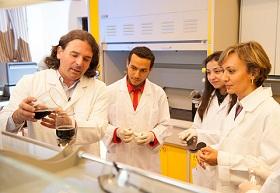Using AI to control energy for indoor agriculture
30 September 2024
Published online 3 June 2013

Researchers at the American University in Cairo (AUC) have come up with a prototype for a hybrid nanocomposite membrane that relies on reverse osmosis to remove salt from seawater. The semi-permeable membrane is made of cellulose acetate, a common polymer found in some adhesives, and tiny cylindrical nanostructures called carbon nanotubes.
The membrane is made of polymeric materials that contain interconnected pores which allow water to pass through while blocking the salt.
Adham Ramadan, the chair of AUC's chemistry department, says improved permeation means less energy would be needed in the reverse osmosis process. Energy requirements are among Egypt's biggest barriers to achieve desalination.
While the membrane gave promising results in the laboratory, it is now being tested in a commercial desalination plant to assess its commercial viability. The researchers have applied for a US patent for the prototype.
"If we increase the share of locally manufactured membranes and other components in desalination plants, the cost of desalinating one cubic meter of water would go down," says Amal Esawi, a mechanical engineer at AUC. "We need to consider cheaper desalination as a national priority."
Esawi notes that Egypt has been lagging when it come to membrane technology. "Most membranes used in desalination plants are imported from the United States or Japan," she says. "This is quite expensive, given that the cost of membranes constitutes 15 to 20% of the cost of the entire desalination plant."
The amount of Nile water that Egypt has access to is fixed despite [the country's] rapid increase in population and its development.
According to a 2010 UNDP report1, Egypt falls below the water scarcity limit of 1,000 cubic metres per person per year, depending on the limited supply of the Nile River for the bulk of its domestic, agricultural and industrial water needs. The country's growing population has meant that the per capita share now stands at 750 m3/ year and is expected to decrease further over the coming years.
"Because of treaties with upstream countries, the amount of Nile water that Egypt has access to is fixed, despite [the country's] rapid increase in population and its development," says Ramadan.
Desalination plants are widely used in neighbouring Gulf states, but their high energy requirements and installation costs have limited their use in poorer Arab states.
"This has limited desalination in Egypt to relatively small-scale plants, primarily for establishments within the tourism industry such as resorts and hotels." says Tarek Samir from the Water Department at Egypt's National Research Center (NRC).
While the AUC prototype may prove beneficial, he suggests reverse osmosis research to reuse water from sewage and industrial waste will be equally important to help solve the country's growing water insecurity.
doi:10.1038/nmiddleeast.2013.83
Stay connected: